Keretapi Tanah Melayu Berhad (KTMB) or Malayan Railway Limited, colloquially referred to simply as KTM, is the main rail operator in Peninsular Malaysia. The railway system dates back to the British colonial era, when it was first built to transport tin. Previously known as the Federated Malay States Railways (FMSR) the Malayan Railway Administration (MRA), and the Malayan Railway, Keretapi Tanah Melayu acquired its current name in 1962. The organisation was corporatised in 1992, but remains wholly owned by the Malaysian government.

KTM Komuter is a commuter rail system in Malaysia operated by Keretapi Tanah Melayu (KTM). It was introduced in 1995 to provide local rail services in Kuala Lumpur and the surrounding Klang Valley suburban areas. Services were later expanded to other parts of Malaysia with the introduction of the Northern and Southern sectors.

Segambut is a sub-district in Kuala Lumpur, Malaysia. The federal constituency represented in the Dewan Rakyat is Segambut.

Batu is a parliamentary constituency in the northern outskirts of Kuala Lumpur, Malaysia, covering the area between Sentul and Batu Caves.

Kepong is a town in northern Kuala Lumpur, Malaysia. The name is a Malay word meaning "Enclose" or "Surround", as the town is surrounded by a mountain range.

Rail transport in Malaysia consists of heavy rail, light rapid transit (LRT), mass rapid transit (MRT), monorails, airport rail links and a funicular railway line. Heavy rail is mostly used for intercity services and freight transport as well as some urban public transport, while rapid transit rails are used for intracity urban public transport in the capital city of Kuala Lumpur and the surrounding Klang Valley region. There are two airport rail link systems linking Kuala Lumpur with the Kuala Lumpur International Airport and Sultan Abdul Aziz Shah Airport. The longest monorail line in the country is also used for public transport in Kuala Lumpur, while the only funicular railway line is available in Penang.

The KTM Tanjung Malim–Port Klang Line, formerly known as the Port Klang Line is one of the three KTM Komuter Central Sector lines provided by Keretapi Tanah Melayu. The electric trains run between Tanjung Malim and Port Klang. Prior to 15 December 2015, the northern terminus of this line was Batu Caves.
Transport in Greater Kuala Lumpur includes a road network, a railway network, airports, and other modes of public transport. Greater Kuala Lumpur is conterminous with the Klang Valley, an urban conglomeration consisting of the city of Kuala Lumpur, as well as surrounding towns and cities in the state of Selangor. The Klang Valley has the country's largest airport, the Kuala Lumpur International Airport (KLIA), as well as the country's largest intermodal transport hub and railway station, Kuala Lumpur Sentral.

Abdullah Hukum station is an integrated rapid transit station in Kuala Lumpur, Malaysia, served by both the LRT Kelana Jaya Line and the KTM Komuter Port Klang Line.

The Sentul Komuter station is a Malaysian commuter train station formerly known as Sentul railway station and is located in the east side of and named after Sentul, Kuala Lumpur. Since 2015, the station has been on the Seremban Line of the KTM Komuter train services. For a long time, this station served as the northern terminus of the Sentul-Port Klang route until the line was extended to Batu Caves, when the station continued to be on the Batu Caves-Port Klang Line until the route change in December 2015 to accommodate the Klang Valley Double Tracking upgrade.
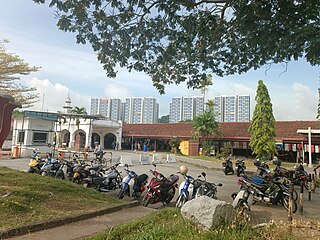
The Seremban railway station is a Malaysian railway station located in the heart of Seremban, the capital of the state of Negeri Sembilan. The station is named after the city.
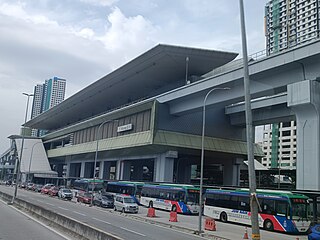
The Kajang railway station is a Malaysian railway station located near and named after the town of Kajang, Selangor. The station is situated 1 km south of Kajang's town centre. However, the MRT Kajang line is also named after the station as well, since it served as a terminus and the final station for the line.

The Sungai Buloh station is an integrated railway station serving the suburb of Sungai Buloh in Selangor, Malaysia, which is located to the northwest of Kuala Lumpur.
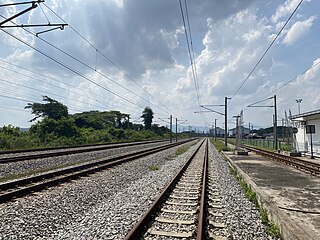
The West Coast railway line runs from Padang Besar railway station close to the Malaysia–Thailand border in Perlis to Woodlands Train Checkpoint in Singapore. It is called the West Coast railway line because it serves the West Coast states of Peninsular Malaysia.

Batu Caves Komuter station is a Malaysian commuter railway station formerly known as Batu Caves Railway station at Batu Caves, Gombak District, Selangor, Malaysia. After redevelopment, the station was reopened in August 2010. The station was from 2010 the northern terminus for the KTM Komuter's Batu Caves–Port Klang Route until December 2015 when the Seremban Line routing was changed to terminate at this station instead of Rawang.
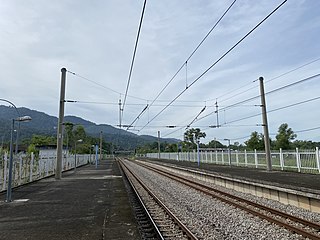
Railway electrification in Malaysia is a relatively recent development of rail transport in Malaysia. While the first railway in the country dates back to 1885, it was not until 3 August 1995 that the first electrified railway service, KTM Komuter, began operations.

The MRT Putrajaya Line (PYL), also known as MRT 2, is the second Mass Rapid Transit (MRT) line in Klang Valley, Malaysia, and the third fully automated and driverless rail system in the country. It was previously known as the MRT Sungai Buloh–Serdang–Putrajaya Line (SSP Line). The line stretches from Kwasa Damansara to Putrajaya and runs through densely populated areas such as Sri Damansara, Kepong, Batu, Jalan Ipoh, Sentul, Kampung Baru, Jalan Tun Razak, KLCC, Tun Razak Exchange, Kuchai Lama, Seri Kembangan and Cyberjaya.
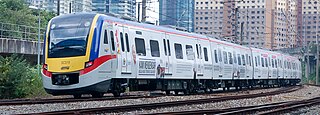
The KTM Batu Caves–Pulau Sebang Line, formerly known as the Seremban Line is one of the three KTM Komuter Central Sector lines provided by Keretapi Tanah Melayu. Its electric trains run between Batu Caves and Pulau Sebang/Tampin. Prior to 15 December 2015, the northern terminus of this line was Rawang.
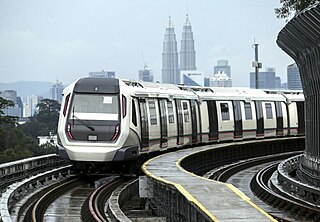
The Klang Valley Integrated Transit System is an integrated transport network that primarily serves the area of Klang Valley and Greater Kuala Lumpur. The system commenced operations in August 1995 with the introduction of commuter rail service on the existing rail between Kuala Lumpur and Rawang. The system have since expanded and currently consists of 11 fully operating rail lines in a radial formation; two commuter rail lines, six rapid transit lines, one bus rapid transit line and two airport rail links to the Kuala Lumpur International Airport's (KLIA) Terminal 1 and Terminal 2, and one temperarily suspended airport rail link to the Sultan Abdul Aziz Shah Airport. The system encompasses 528.4 kilometres (328.3 mi) of grade-separated route on standard gauge and metre gauge with 197 operational stations.


















